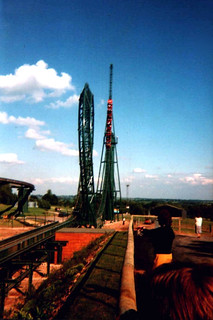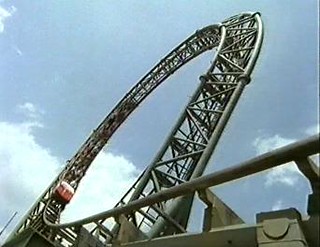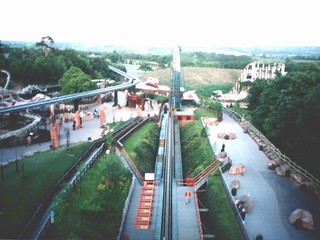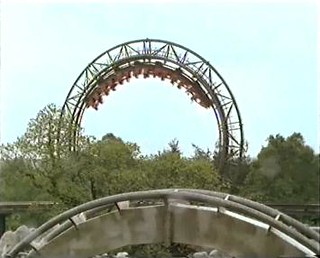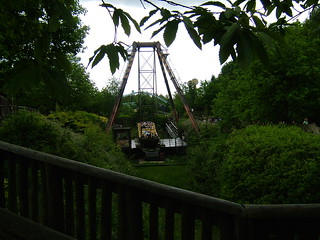Thunder Looper
Thunder Looper was one of the iconic coasters of the 90s at Alton Towers. Though it only lasted six seasons in the park, it remains one of the park's most fondly remembered thrill rides despite its relatively short life span.
Thunder Looper was a shuttle coaster where the train was launched out of the station and into a loop, before riding up a spike of track until it ran out of energy. The train would then roll backwards through the loop before passing through the station and up a second spike of track, then the train would roll back into the station where breaks would bring you to a halt.
One of the most interesting parts of the ride was the method of launch used. Modern launch roller coasters use either a hydraulic or air powered pulley system, or a strip of electro-magnets to speed the trains up the launch track. Thunder Looper however, pre-dated these technologies, therefore the launch was provided a large metal bucket filled with weights concealed in a huge tube, incorporated into the structure of the far end track spike. The bucket was winched to the top of the tube, then its cable engaged to a second cable via a clutch. This cable was attached to a small catch-car on wheels that would be positioned behind the train. Once ready the bucket would be released, pulling the cable with it and in turn the catch car, sending the train hurtling into the first inversion.
The Life & Times
In 1987 a mystery unfolded at Alton Towers when the new Sky Ride opened to help transport guests around the park. Half way along the course an impressively large station was included at the ride's turning point, which delivered guests into a large empty field at the far end of the Gardens.
For several years the turn station hinted at the potential for a park expansion but it wasn't until 1989 that guests got a first taste of what John Broome actually had in mind to draw guests to the new area. A trip on the monorail towards the end of the season revealed the parts of a coaster strewn across the area ready for installation.
The parts offered a tantalizing hint at the coaster that would greet guests the following season, but for those in the know, the ride laid out on the lawn could easily be identified as one of the original Schwarzkopf Shuttle Loops, which had opened as King Kobra for Kings Dominion in 1977.
In 1990, the view from the Monorail had changed dramatically as Thunder Looper now towered over the area as the park's striking new addition. The new coaster pushed the boundaries of what the park was able to install and thus was only granted a temporary planning permission
The arrival of Thunder Looper signalled the start of coaster golden age for this corner of the park and soon it was joined by The Beast and Beastie in the newly formed Thunder Valley. But it was the arrival of Nemesis that really put the area on the map, though Thunder Looper could more than hold its own alongside its new thrilling neighbour.
What happened next...
Thunder Looper was named for two of its most distinctive attributes - and ultimately both of these features played a part in the coaster's downfall. There is no denying the ride was tall, very tall - the only coaster at Alton Towers with a longer drop is Oblivion, much of which is buried underground. Even the loop of the ride stood 10m above the tree line and so the ride was clearly visible in nearby villages.
But it was the ride's signature roar that was the primary factor that would ultimately see the coaster depart from Alton Towers after only six seasons. Both the launch mechanism and the roar of the train along the track combined to produce a rumble that earned it the name of thunder. This constant rumble was not only disturbing for locals who could not only see the ride but also clearly hear it - if rumour is to be believed, it also caused distress for local livestock, leading to cows calving at the wrong time of year.
It is likely however that the final nail in the coffin came from the newly built Alton Towers Hotel. Noise from Forbidden Valley is often very audible from the hotels and it is likely that hotel guests were also disturbed by the coaster during its routine maintenance checks each morning before the park opened.
A combination of these issues, alongside growing maintenance costs, meant that when the coaster's temporary planning permission was up for renewal it made little sense for the park to renew and so after only six years in the park Thunder Looper was replaced by Ripsaw and The Blade for the 1997 season.
But the story didn't end there... and if you want to ride Thunder Looper today all you need is a ticket to Brazil, where the coaster now operates at Hopi Hari Parque de Diversão. The Thunder Looper reopened in 1999 as Catapul and since 2012 has operated with an impressive Superman Comic Book overlay.
Despite leaving Forbidden Valley over twenty years ago, the impact of the Thunder Looper can still be seen today in the distinctive landscape of the area. The pit that The Blade occupies was originally carved out to house the Thunder Looper to reduce the coaster's height within the landscape.
The spot where The Blade swings back and forth today is more or less the same location as the Thunder Looper's station was once located. Much of the coaster's queue line was also reused for both The Blade and Ripsaw.


